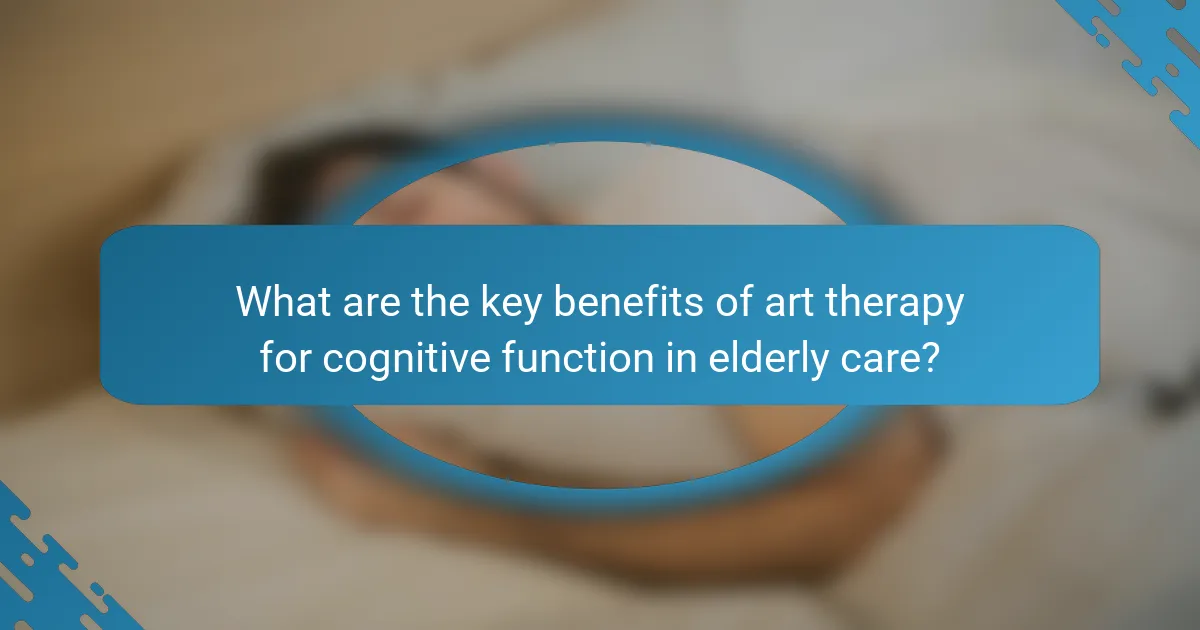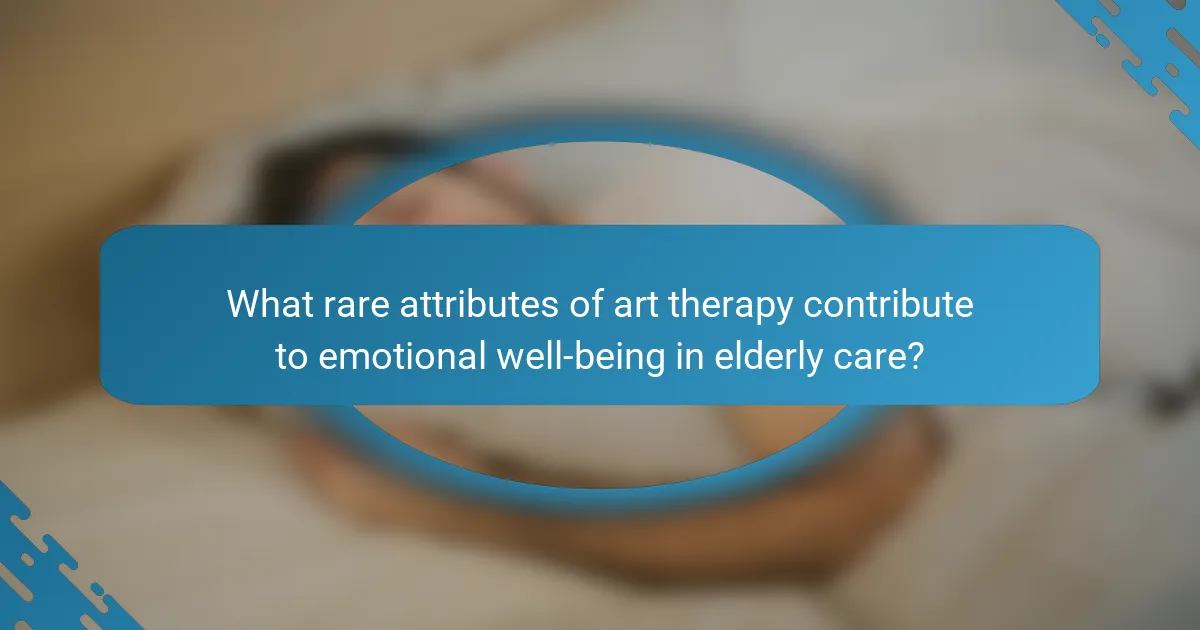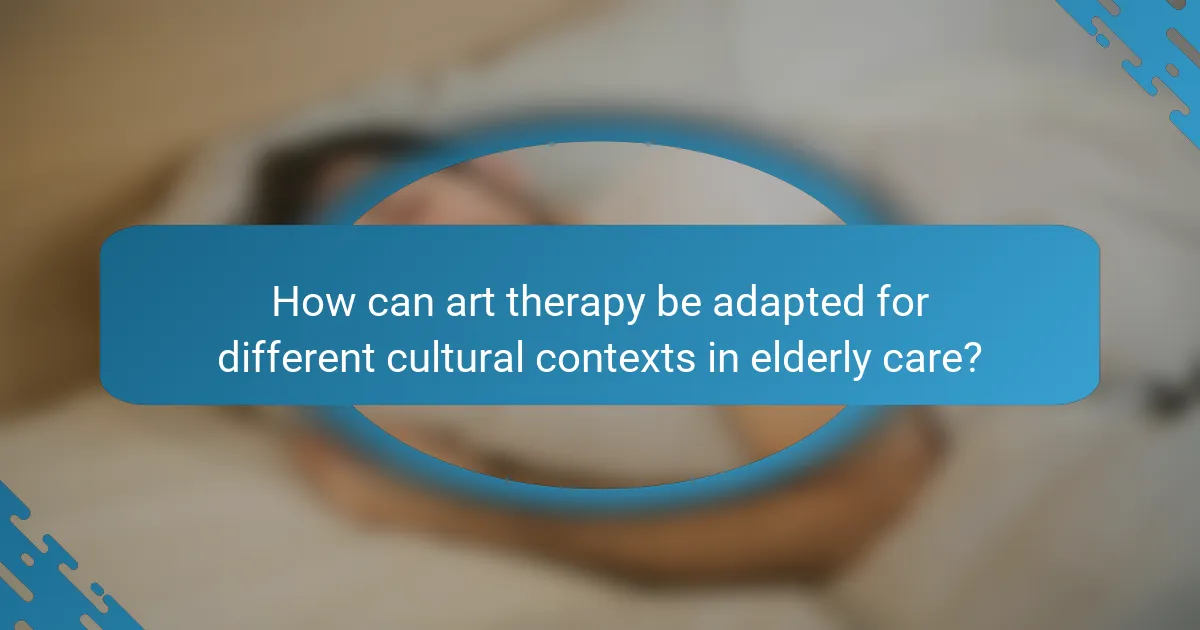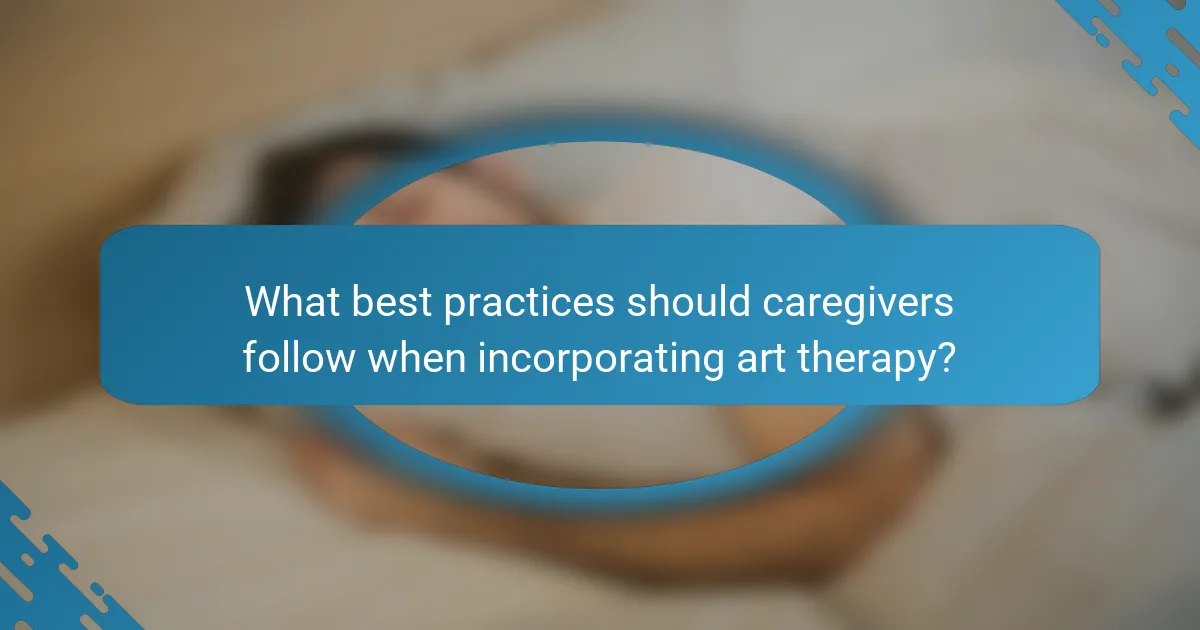Art therapy significantly boosts cognitive function and social interaction in elderly care. It enhances memory and problem-solving skills while fostering emotional expression. Group activities promote collaboration, reducing feelings of isolation. Additionally, personalized approaches can adapt art therapy to cultural contexts, further enriching engagement and community building.

What are the key benefits of art therapy for cognitive function in elderly care?
Art therapy significantly enhances cognitive function and social interaction in elderly care. It stimulates brain activity, improving memory and problem-solving skills. Engaging in creative activities fosters emotional expression, reducing anxiety and depression. Additionally, art therapy promotes social connections, as group sessions encourage interaction and collaboration among participants, enhancing their sense of community.
How does art therapy enhance memory retention in older adults?
Art therapy enhances memory retention in older adults by stimulating cognitive processes and encouraging creative expression. Engaging in art activities promotes neural connections, improving recall and recognition. Research shows that older adults participating in art therapy experience significant memory improvements, as creativity can activate different brain regions involved in memory. Additionally, social interaction during group art sessions fosters emotional connections, further supporting cognitive function.
What role does art therapy play in improving problem-solving skills?
Art therapy significantly enhances problem-solving skills in elderly care by fostering creativity and cognitive engagement. It encourages participants to express thoughts visually, which can lead to improved analytical thinking. Engaging in art activities stimulates brain regions associated with problem-solving and decision-making. A study found that elderly individuals participating in art therapy showed a 30% increase in cognitive flexibility, enabling better adaptation to new challenges. This unique attribute of art therapy offers a therapeutic approach that not only promotes artistic expression but also strengthens essential cognitive functions.
How can art therapy stimulate creativity and cognitive flexibility?
Art therapy enhances creativity and cognitive flexibility by engaging individuals in expressive activities that stimulate brain function. It encourages problem-solving and adaptive thinking through artistic expression. Studies show that art therapy improves mental agility, allowing elderly participants to explore new ideas and perspectives. As a result, this form of therapy fosters social interaction, reducing feelings of isolation while enhancing emotional well-being.

What unique aspects of art therapy foster social interaction among the elderly?
Art therapy uniquely enhances social interaction among the elderly by fostering creativity and communication. Engaging in art encourages expression, reducing feelings of isolation. Group activities promote collaboration, allowing participants to share experiences and build relationships. Moreover, art therapy can improve cognitive function, which supports more meaningful interactions. The collaborative nature of art sessions creates a sense of belonging, vital for emotional well-being in elderly care.
How does art therapy promote communication skills in seniors?
Art therapy enhances communication skills in seniors by fostering self-expression and reducing anxiety. Engaging in creative activities encourages verbal and non-verbal interaction, allowing seniors to convey thoughts and emotions more freely. This form of therapy often leads to improved social connections, as participants share their art and experiences with others. Studies indicate that art therapy can significantly enhance cognitive function, promoting memory recall and increasing confidence in communication abilities. Overall, art therapy serves as a valuable tool for enhancing social interaction and cognitive engagement among the elderly.
What are the effects of group art therapy sessions on social bonding?
Group art therapy sessions enhance social bonding by fostering communication and collaboration among participants. These sessions create a safe environment where elderly individuals can express themselves creatively, leading to increased trust and shared experiences. As a result, participants often develop stronger relationships and a sense of belonging. Studies indicate that engaging in group art therapy can improve social interaction skills, reduce feelings of loneliness, and enhance overall emotional well-being. This collective engagement is vital for cognitive function and emotional support in elderly care.
What types of group activities are most effective for social interaction?
Art therapy group activities are highly effective for enhancing social interaction among the elderly. These activities foster communication, collaboration, and emotional expression.
Creative sessions, such as painting or sculpting, encourage participants to share experiences and feelings, promoting connection. Group discussions about art can stimulate cognitive function and enhance social bonds.
Incorporating music and movement in art therapy can further engage participants, leading to improved mood and socialization. Regular participation in these activities has been linked to increased self-esteem and reduced feelings of isolation among seniors.
Overall, art therapy serves as a valuable tool in elderly care, facilitating meaningful social interactions and cognitive benefits.

What rare attributes of art therapy contribute to emotional well-being in elderly care?
Art therapy offers unique attributes that enhance emotional well-being in elderly care, such as fostering creativity and self-expression. These rare aspects can lead to improved mood and reduced anxiety. Engaging in art activities provides a sense of accomplishment, promoting self-esteem. Additionally, art therapy encourages social interaction, helping to combat feelings of isolation common in elderly populations. As a result, these attributes contribute significantly to overall emotional health and quality of life for seniors.
How does art therapy address feelings of loneliness and isolation?
Art therapy effectively reduces feelings of loneliness and isolation in elderly individuals by fostering social interaction and enhancing cognitive function. Engaging in artistic activities allows participants to express emotions and share experiences, creating connections with others. Studies show that art therapy can improve mood and reduce anxiety, leading to increased social engagement. Additionally, the collaborative nature of group art sessions encourages communication, helping to build supportive relationships among participants.
What unique art forms are particularly beneficial for emotional expression?
Unique art forms beneficial for emotional expression include painting, music therapy, dance, and drama therapy. These forms facilitate cognitive engagement and enhance social interaction among elderly individuals. For instance, painting allows for personal expression and reflection, while music therapy can evoke memories and emotions. Dance encourages physical movement, improving both mental and physical health. Drama therapy fosters social connections through role-playing and storytelling, making it a unique tool in elderly care. Each art form offers distinct benefits that contribute to emotional well-being and cognitive function.

How can art therapy be adapted for different cultural contexts in elderly care?
Art therapy can be effectively adapted for different cultural contexts in elderly care by incorporating culturally relevant themes and techniques. This personalized approach enhances cognitive function and social interaction. For instance, using traditional art forms from a specific culture can foster a sense of belonging and identity among elderly participants. Additionally, understanding cultural norms around communication and expression allows therapists to create a safe space for sharing and interaction. Integrating local art materials and practices can also enhance engagement, making art therapy more meaningful and impactful for diverse elderly populations.
What cultural considerations should be taken into account when implementing art therapy?
Cultural considerations in art therapy for elderly care include understanding diverse backgrounds, communication styles, and artistic preferences. Recognizing unique cultural expressions fosters engagement and enhances cognitive function. Additionally, respecting traditions and values promotes social interaction and emotional well-being. Integrating culturally relevant themes can lead to more meaningful therapeutic experiences.
How does regional art influence therapeutic practices?
Regional art significantly enhances therapeutic practices by fostering cognitive engagement and promoting social interaction among the elderly. Diverse artistic expressions from various cultures stimulate mental activity, encouraging memory recall and creativity. This connection with local art can lead to improved emotional well-being and a sense of community. Studies show that art therapy, when infused with regional elements, can reduce feelings of isolation and increase participation in group activities. Engaging with familiar cultural themes in art helps seniors relate better to their surroundings and enhances their overall quality of life.

What best practices should caregivers follow when incorporating art therapy?
Caregivers should prioritize creating a safe, supportive environment for art therapy. This enhances cognitive function and promotes social interaction among elderly participants.
1. Assess individual needs and preferences to tailor activities.
2. Encourage self-expression without judgment to foster creativity.
3. Facilitate group sessions to enhance social bonding and communication.
4. Utilize diverse art forms to stimulate cognitive engagement.
5. Regularly evaluate progress and adapt approaches based on feedback.
What common mistakes should be avoided in art therapy for elderly care?
Common mistakes in art therapy for elderly care include neglecting individual preferences, rushing sessions, and lacking a structured approach. Failing to recognize cognitive limitations can hinder engagement. Additionally, not fostering social interaction may reduce the therapy’s benefits. Always tailor activities to the unique abilities and interests of each participant to enhance cognitive function and social connection.
How can caregivers optimize the benefits of art therapy for seniors?
Caregivers can enhance art therapy for seniors by fostering a supportive environment and encouraging expression. Engaging seniors in creative activities promotes cognitive function and social interaction. Providing varied materials, such as paints and clay, stimulates creativity. Group sessions create social bonds, reducing feelings of isolation. Regular participation can lead to improved mood and mental health, as studies show a 30% increase in cognitive engagement through art therapy.